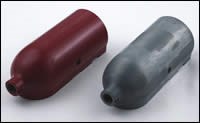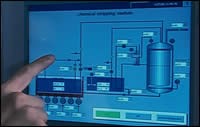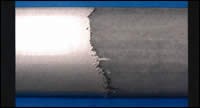Teaming Up on Rejects
Joint venture brings innovative paint stripping technology to U.S.
Over the years, a number of methods have been used to remove reject coatings from finished parts, including media blasting, burn-off, or chemical removal. Some of these methods may cause issues with the part substrate, requiring further rework of some kind before the part can be recoated. Obviously, the easiest and most preferred method would be a removal mechanism that leaves the part ready for coating immediately after stripping with no additional work needed.
Over the past several years a chemical stripping formulation and process has been developed and launched successfully that is capable of stripping a part with no further work needed prior to coating. This method has also now been improved upon with a new and unique way of processing the parts.
In response to the growing demand for higher-performance coating removal services, Kolene Corp. (Detroit) and ABL-Technic GmbH (Leutkirch, Germany) have partnered to offer a new coating removal system that is efficient and virtually closed-loop with minimal vapor loss.
Kolene supplies the chemistry for the new technique. Its Recover 5000, a proprietary, low-temperature organic cleaning solution, is used to strip organic coatings from high-value components that have defects in the paint finish. The solution saves time, materials, and energy while providing an environmentally sound alternative to conventional solvents. The resulting stripped components are generally cleaner than a brand new part and can go directly back to the paint line with no additional cleaning needed.
ABL-Technic has been involved in customized coating removal for more than 30 years. With 13 locations around the world, its services are used by global customers including Audi, BMW, Bosch, Case, DaimlerChrysler, Decoma, Electrolux, Ford, Johnson Controls, Hayes Lemmerz, Magna, Opel, Renault, Siemens, Thyssen, Valeo, Volvo, and VW.
These partners have worked together to develop a new stripping technology that combines Kolene’s chemistry with ABL-Technic’s ChemJet spray hardware. The combined technology can help reduce capital costs and floor space requirements while improving chemical and energy efficiency and maintaining the highest environmental standards.
Before its U.S. introduction, the resulting spraying system was tested extensively in Germany. Variations in temperature, chemistry, and process times were examined. During this testing the equipment was optimized for ease of use and maximum efficiency with environmental controls in place. A full turnover of the chemical bath was conducted with both the original prototype and the first commercial unit before shipment to the U.S.
How It Works
The ChemJet process is a highly efficient, low-pressure spray coating removal technique. Self-contained and compact (when compared to alternative removal methods), its advantages are numerous.
The process is performed in a modular system consisting of two chambers: a chemical stripping chamber using Recover 5000 and a separate water rinse chamber. To improve cleaning, flexibility, and chemical life, the chemical chamber operates over a temperature range from ambient to about 300°F.
Parts are loaded onto heavy-duty, stainless steel fixtures. With up to three levels of parts loading and spray risers for full impingement, the cabinets each have about 128 cu ft of storage capability. Keep in mind these units can run the same number of parts as immersion equipment, which is much larger in size with much larger chemical tanks. The units use a more vertical profile to save on floor space, and fixtures are moved on transportable carts and loaded on turntables in cabinets capable of holding 1,100 lb.
The stripping chemical is stored in a heated, oil-jacketed reservoir with a flow-through basket where activation additives are also introduced to enhance the solution’s stripping capabilities. The chemical reservoir tank has a liquid seal to minimize vapor loss during operation as well as an electronically controlled damper to minimize vapor loss to the outside environment. This system is constantly monitored and updated through a variety of sensors all tied into a computerized control panel.
The ChemJet system uses a touch-screen PLC operator interface with automatic controls and multiple programs. The screen provides easy-to-read graphics representing the chemical stripping module, rinsing module, heaters, doors, pumps, and switches. Sensors provide information for such items as temperature, level control, process sequence and timing, and turntable rotation. One operator easily runs the whole system.
In the rinse chamber, there are options for hot water, cold water, and deionized water at different stages of the rinse cycle, if needed. Water is recirculated to minimize consumption. A constant pH monitoring system is installed on the rinse water tank to insure that the water spraying on the parts is neutral and will not be a problem to the environment. This also helps to maintain consistent part quality.
The system includes fail-safe controls and emergency shut-offs. Process control information can be recorded and analyzed for quality control and SPC. The system is simple to use yet sophisticated in the elements it monitors. This helps to insure consistent part stripping and repeatable workloads. Times for the various process steps are preset and temperatures are monitored for optimum stripping performance. This automation gives the operator time to perform other tasks such as part loading and unloading while the system monitors the current process.
Due to the unit’s design and construction, the system can process more parts in a smaller area than conventional stripping systems. Also, due to impingement by water in the rinsing tank, parts come out very clean and ready to be re-coated with minimal time in the rinse stage. Even parts with complex geometries that can require ultrasonic cleaning after immersion stripping are less of a problem to rinse clean with the ChemJet unit.
Chemistry
Over the past five years, literally thousands of metallic and non-metallic automotive and industrial parts have been stripped using Recover 5000 chemistry in a simple immersion stripping and immersion rinsing system. After stripping these parts are ready to be painted again without further processing.
Extensive testing has been performed to ensure the parts suffered no deleterious effects due to stripping. This testing involved assuring both that the part substrate was not changed and also the repainting process was successful. Tests such as adhesion, impact, abrasion, gravelometer, humidity resistance, and so forth have been performed on coatings, while substrate tests such as elongation, tensile strength, hardness and microstructure, have all been examined.
The Recover 5000 chemistry is compatible with ferrous alloys (including galvanized steels), nonferrous metals, and even select non-metallic substrates. There is little or no surface reaction, and the solution will not damage or attack substrates even after multiple stripping operations. This is quite different from traditional acid or basic strippers, which can cause dulling, staining or pitting of metallic surfaces.
The basic stripping reaction involves dissolution of all cured coating layers. This means the organic portion of the coating goes into solution, while the common inorganic components remain in suspension. Once stripping is complete, the parts are allowed to drain and then water-rinsed.
Because some coating constituents go into solution, the life of the process chemical is varies from application to application and is influenced by the type(s) of coating(s) to be removed, amount of total coatings removed and the physical complexity and geometry of the parts being stripped. Typically, most processors will see months of use before the chemical will need to be pumped out and replaced. The waste product is non-hazardous and easy to dispose of. It can even be sold off and used as a fuel in some areas.
Required stripping times depend on the thickness and type of coating to be removed and on bath loading. They generally range from 10-15 min for a single layer of electrocoat to 90 min or more for multi-layer coatings. Because of the benign nature of the process, minimal or no base metal changes are observed even during extended exposures. The process is also capable of removing multiple layers of assorted coatings at one time. This includes e-coats, powder and liquid coatings. Very durable clearcoat layers are also easily removed with this chemical stripper.
A more recent development of the Recover 5000 process is stripping of plastic parts. New applications include removing multi-layer automotive-grade coatings from nylons and thermoplastic olefins (TPOs). Organic topcoat and vacuum metal-deposited coatings have been successfully removed from bulk molding compound (BMC) light housings without affecting the underlying basecoat.
Equally important to stripping performance is repaint success. Stripped nylon, TPO, and BMC components have been successfully re-coated without any special handling, and adhesion, humidity and water immersion testing after re-coating has yielded excellent results.
Even though the process operates at a fairly low temperature, one of the concerns with a post cleaning operation of a heat-treated component was the effect of stripping on the part’s microstructure and mechanical properties. Knowledge of the initial heat treatment and the engineering properties and microstructure condition of the part prior to chemical stripping was essential. Following the stripping operation, a subsequent evaluation of the properties and microstructure determined any significant changes resulting from stripping procedures.
For stripping of cast aluminum wheels, for example, automakers have defined appropriate material and engineering specifications for the components. An evaluation was conducted to ascertain what affect Recover 5000 stripping would have on the wheels’ microstructure and mechanical properties. The tests aimed to determine any change in mechanical properties resulting from a series of time/temperature thermal schedules. These schedules would encompass cycles consistent with the Recover process: temperature range of 250-350ºF and time range of 30 min to 3.5 hr.
First, workers examined microstructure and recorded hardness recorded on “as-received” wheels. A number of wheel specimens were then stripped to establish a time/temperature matrix of stripping effects.
Change in properties was defined by a measured change in hardness using the Rockwell K scale, a 1/8-inch ball and a 150 kg load. Microstructure and hardness were checked again in “as stripped” condition, and any hardness changes were measured at three different locations on the wheel: rim, web (spoke) and hub. Results conformed with specifications for tensile strength and yield strength.
Metallurgical tests have also been performed to demonstrate that galvanized layers, and phosphate pretreatment crystal structures are not affected by the Recover process.
Because the stripper chemistry causes no base metal reaction metal loss, it allows rapid reprocessing of sensitive substrates and refinishing of rejects. No touch-up is needed, for example, on polished surfaces. Faster cleaning cycles along with process optimization minimize turnaround time along with reducing labor and handling costs.
One of the biggest areas of savings was reject parts inventory. Where rejects were previously stored color-for-color for finessing, stripped parts could instead be returned directly to finishing or stored in a clean state for the next scheduled parts run in any color. This system has been successful with roof rack components, window frames, bumpers, moldings and hood scoops.
Will It Work for You?
To evaluate a potential application, parts are submitted for testing at the RecoverTechnic Pilot Lab. Workers gather information on the type of substrate, the paint system, and current stripping method. Film build measurements are also taken, and the parts are weighed before and after stripping to determine paint weight. Photographs of the parts before and after processing are taken for customer reference.
Parts are then processed through the Pilot Lab to define the most effective stripping sequence. Unique considerations such as polished areas, lap seams, and other part conditions are also noted. All of this information is summarized in a report for the customer. This can then be used in designing a line and equipment for the customer’s location or for tolling purposes.
Lab data can even be compiled into a customer analysis tool called the Total Cost of Cleaning Analysis (TCCA). The TCCA takes process information from the lab report and estimated equipment costs, combined with customer production levels, utility and labor costs to provide an estimated overall operating cost and cost per piece. The TCCA has proven to be a valuable tool for project analysis and decision-making.
Related Content
Robots, AI and Superb BMW Surfaces
There isn’t an automotive paint shop in the world that doesn’t have post-paint inspection and defect processing. But BMW is doing this with levels of technology at a plant in Germany that exceed all other paint shops in the world.
Read MoreHenry Ford Is Still Right When It Comes to Color
Who would have imagined that more than 100 years after his famous statement about any color as long as it’s black would still have relevance of a sort?
Read MoreShedding Light on Surface Inspection
State-of-the-art reflector-based lighting system improves luminosity and ergonomics for surface inspection tasks while reducing energy usage.
Read MoreProducts Finishing Reveals 2024 Qualifying Top Shops
PF reveals the qualifying shops in its annual Top Shops Benchmarking Survey — a program designed to offer shops insights into their overall performance in the industry.
Read MoreRead Next
Episode 45: An Interview with Chandler Mancuso, MacDermid Envio Solutions
Chandler Mancuso, technical director with MacDermid Envio discusses updating your wastewater treatment system and implementing materials recycling solutions to increase efficiencies, control costs and reduce environmental impact.
Read MoreEducation Bringing Cleaning to Machining
Debuting new speakers and cleaning technology content during this half-day workshop co-located with IMTS 2024.
Read MoreA ‘Clean’ Agenda Offers Unique Presentations in Chicago
The 2024 Parts Cleaning Conference, co-located with the International Manufacturing Technology Show, includes presentations by several speakers who are new to the conference and topics that have not been covered in past editions of this event.
Read More























.jpg;maxWidth=300;quality=90)







